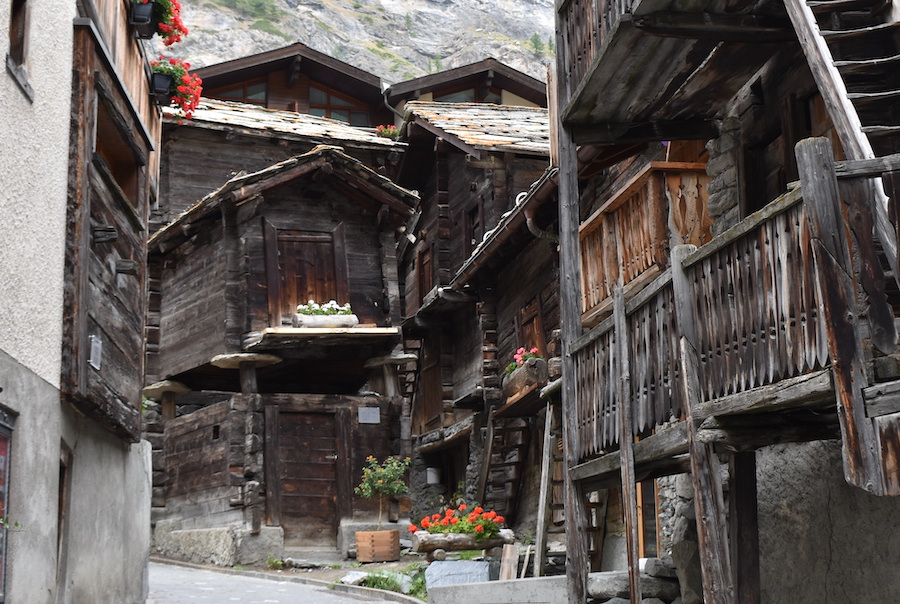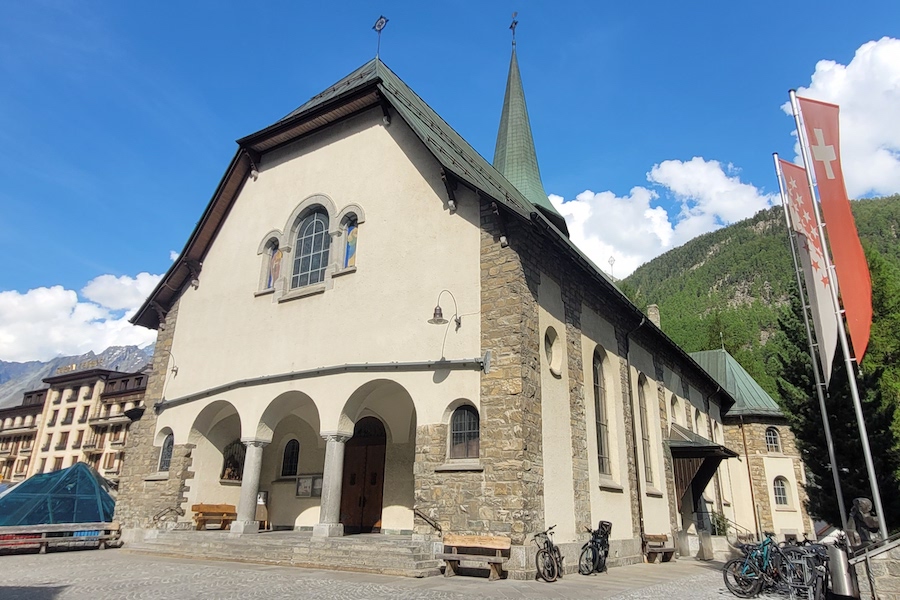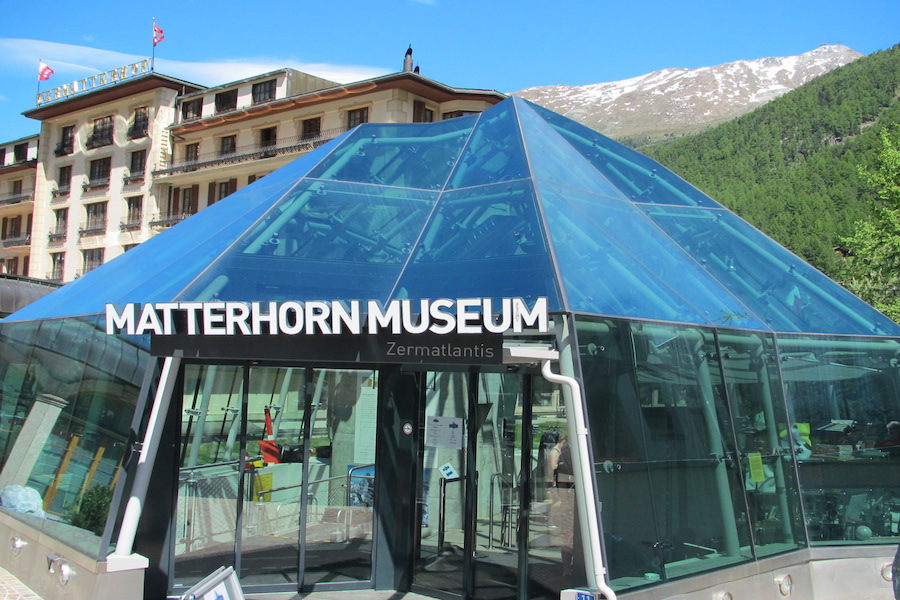Welcome to our blog on the history of Zermatt, a picturesque town nestled in the heart of the Swiss Alps. With its stunning location at an elevation of 1,610 meters above sea level and surrounded by 22 majestic four-thousand-meter peaks, Zermatt has been a magnet for mountaineers and climbers from around the globe for centuries. Join us, as we delve into the fascinating history and natural wonders of Zermatt, where timeless beauty meets the forces of change.
Zermatt has approximately 5800 inhabitants and is situated at 1620 m. above sea level. Because of its size (243 km2), Zermatt is one of the largest municipalities in Switzerland and borders directly on Italy. The border is only passable on foot or on skis due to the glacier, and became the venue for the Ski World Cup in November 2022. 22 four-thousand-meter peaks lie entirely or partially on Zermatt territory, including the Dufourspitze at 4634 m. above sea level, the highest mountain in Switzerland.
From Zermatt and the communities below (Täsch, Randa) you can reach a total of 38 four-thousand-meter peaks and the region therefore been famous for centuries among mountaineers and climbers from all over the world.
The Mattervispa River is the result of the union of four large glacial rivers: the Zmutt Glacier, Gorner Glacier, Trift Glacier, Findel Glacier. The Mattervispa is the river flowing right through the heart of Zermatt (the locals call it the "Vispa"), and you see it from almost everywhere.
In the old village, to the left of the Bahnhofstrasse after the Mont Cervin Hotel, there are about 30 buildings built in the traditional style of the Valais mountain farmers. The granaries were used to store hay and food such as dried meat. The houses are up to 500 years old and date from the 16th to 18th centuries. They stand on stone stilts to keep mice away and are made of larch wood (the area around Zermatt is full of larches). The wood has a lot of resin and is therefore more resistant to pests. The sunlight and weathering turns the wood black – so it can store heat well. Their remnants have become a symbol for the history of Zermatt.

View of the historic part of Zermatt. (© Zermatt Holidays)
At the end of the old village there is a fountain dedicated to an important figure in the history of Zermatt: the mountain guide Ulrich Inderbinen. The fountain was created on the occasion of his hundredth birthday. Inderbinen was born in 1900 and climbed the Matterhorn for the first time at the age of 21. As a mountain guide, he experienced the total collapse of guests during the Second World War, and it was not until 1960 that ascents were made again. He was on the Matterhorn a total of 371 times, the last time at the age of 90. He died at the age of 104.
The water from the fountain is fresh spring water and can be drunk with pleasure.
The Marmot fountain can be found at the Church Square, which was created in 1906 and is also called Prato Borni fountain – the old name of Zermatt. There are many Marmots living in the surrounding area.
On the back you will see a bronze capricorn; the capricorn was a real one, which died in an avalanche. A local craftsman made a plaster cast of it and created the bronze figure from it.
The Monte Rosa Hotel was built as the very first hotel of Zermatt in 1839 and still stands today in its timeless form. The Bahnhofstrasse leads you directly to the hotel. A coffee or drink in Edward’s Bar will take you back to the old days. In the bar, the walls and beams of the first building are still preserved.
The village church was built as early as 1285, but has been enlarged and renovated several times since then. It is a Roman Catholic church; 81% of the population of Zermatt is Roman Catholic.

The Zermatt church on the village square is a meeting place for the locals. (© Zermatt Holidays)
A visit to the Matterhorn Museum gives all history geeks an interesting insight into the life of the past mountain dwellers. Next to facts about the history of Zermatt, you will also find the first ascent of the famous Matterhorn and some insights into the animal and natural world of the area around Zermatt. Children up to 9 years may enter for free, adults pay 12 CHF. (Opening hours can be found here).

In the Matterhorn Museum, also called Zermatlantis, you can learn everything about the world-famous mountain. (© Zermatt Tourism)
In the mountaineers’ cemetery behind the church lie gravestones of about 50 victims from all over the world. They died, for example, due to avalanches, rockfalls and crevasses.
The gravestones of Peter Taugwalder and son also lie here. They were the guides of the first climber of the Matterhorn Edward Whymper in 1865. Only these three people survived the first ascent, four others died.
A monument entitled “Tomb of the Unknown Climber” can also be seen here. Since the first ascent, there have been over 500 deaths on the Matterhorn, and 27 have not been found to date. This monument is dedicated to these people.
From the Church Bridge you have an uninterrupted view of the infamous Matterhorn. Tourists from all over the world gather here to get a snapshot.
When looking at the history of Zermatt, it also is interesting to look at future developments. The Matterhorn is changing; researchers at ETH Zurich are monitoring the Matterhorn and noting that the rocks are becoming more and more brittle.
In the summer of 2022, mountain guides are temporarily advising against climbing the mountain because of the uncertain situation.
The Alps Glaciers are also changing; their retreat is affecting wildlife and nature, as well as the people who live in the mountains. On the climate Audio Trail you can learn more about the world of glaciers and mountains and their corresponding climate.
In conclusion, Zermatt is more than just a picturesque alpine town—it's a testament to human determination and a symbiotic relationship with the majestic mountains. From its rich mountaineering history and traditional village charm to the awe-inspiring Matterhorn and cultural landmarks, Zermatt offers a captivating journey through time and nature. As you explore the history of Zermatt and immerse yourself in its breathtaking beauty, let it inspire you to cherish and care for the delicate balance between humanity and the environment.
Do not forget to follow us on Instagram or Facebook for daily updates and travel tips!
Falls Sie Fragen zu diesem Artikel, oder zu unseren Ferienunterkünften haben, kontaktieren Sie uns bitte über +41 27 968 11 30 oder per Mail an: info@zermattholidays.com
© 1999 - 2024 Zermatt Holidays.
phone-square
facebook-square
tripadvisor
instagram